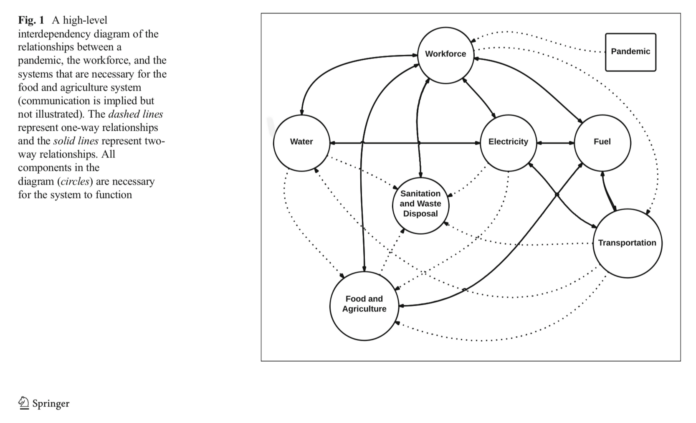- “The USA’s food system’s critical points are in the middle of the supply chain. This creates a bottleneck effect where there are a large number of farmers and producers, and a large number of consumers, but there are not many processing and packaging plants in the middle of the supply chain (Burger et al. 2010). The reliance on these choke points creates vulnerability where a disruption to the food system’s workforce at processing plants, packaging plants, and distribution centers could disrupt the entire food supply chain,” (Huff 2015 p.339)
- Disruption in the food supply chain in other countries will cause disruptions in the U.S. food supply chain, (339).
- “Consumers do not generally store large amounts of food (Sennebogen 2011), in part because a large number live in cities without much personal storage space…Currently, 50 % of people worldwide live in cities, and this percentage is expected to rise to 60 % by 2030 (National Intelligence Council 2013). This will likely exacerbate the problem of small amounts of individual food storage, especially during events that cause disruptions to the food supply chain. Another cause of small individual stores of food is poverty. During the 2002– 2004 SARS outbreak in Asia, most people had very little food stored at home (Lederman et al. 2009). The combination of the food supply chain disruption due to the SARS outbreak and the minimal individual stores of food created a situation where many people had difficulty obtaining food. A similar situation could be caused by a wide variety of infectious agents (Brown 2009),” (339–340).
- “[M]any aspects of the food system are labor intensive (i.e., transportation, wholesale, pro- cessing, and farming) and estimated that a 25 % reduction in labor would cause a 49 % reduction in food production. Their analysis concluded that with a 10 % reduction in labor all elements would remain operational, though there would be major shortages. However, the absenteeism rate of 10 % in the NISAC study was highly optimistic. Absenteeism in a severe pandemic could be as much as 20–40 % (DHS 2006; FFIEC 2007; OSHA 2007).
How resilient is the United States’ food system to pandemics
Huff 2015


